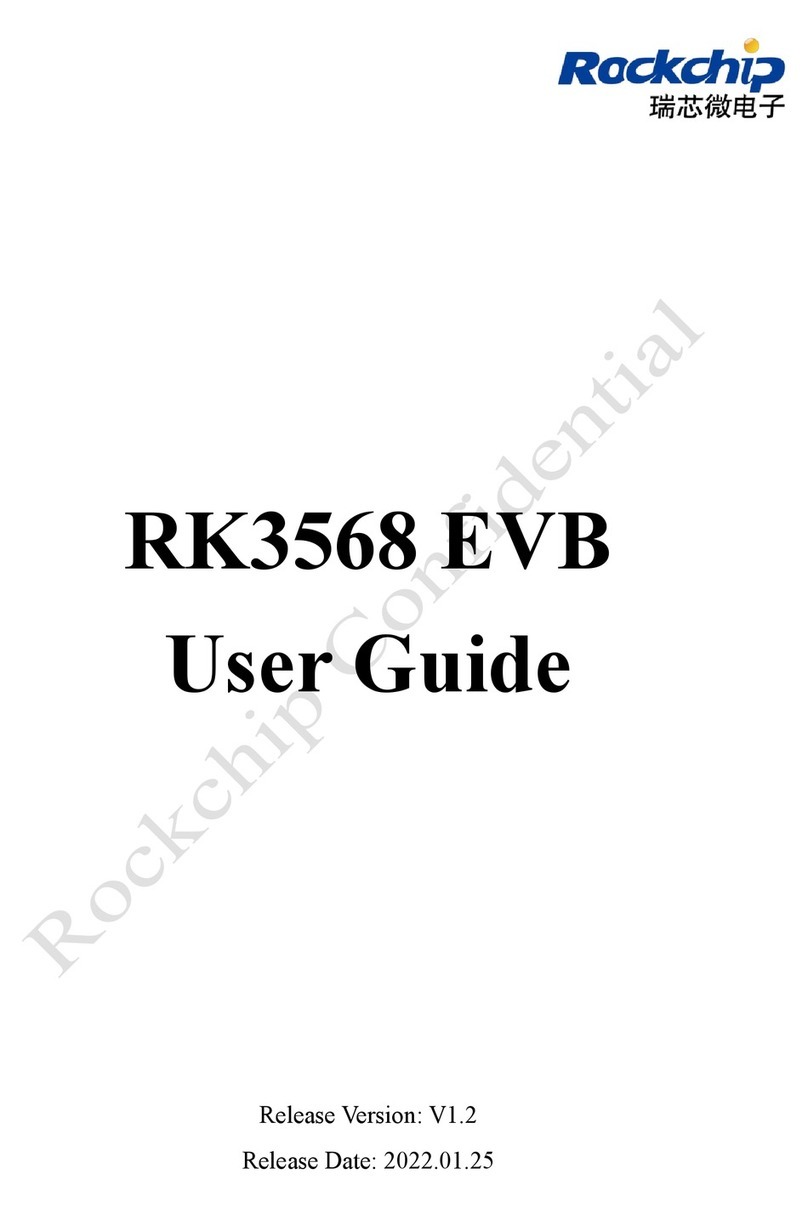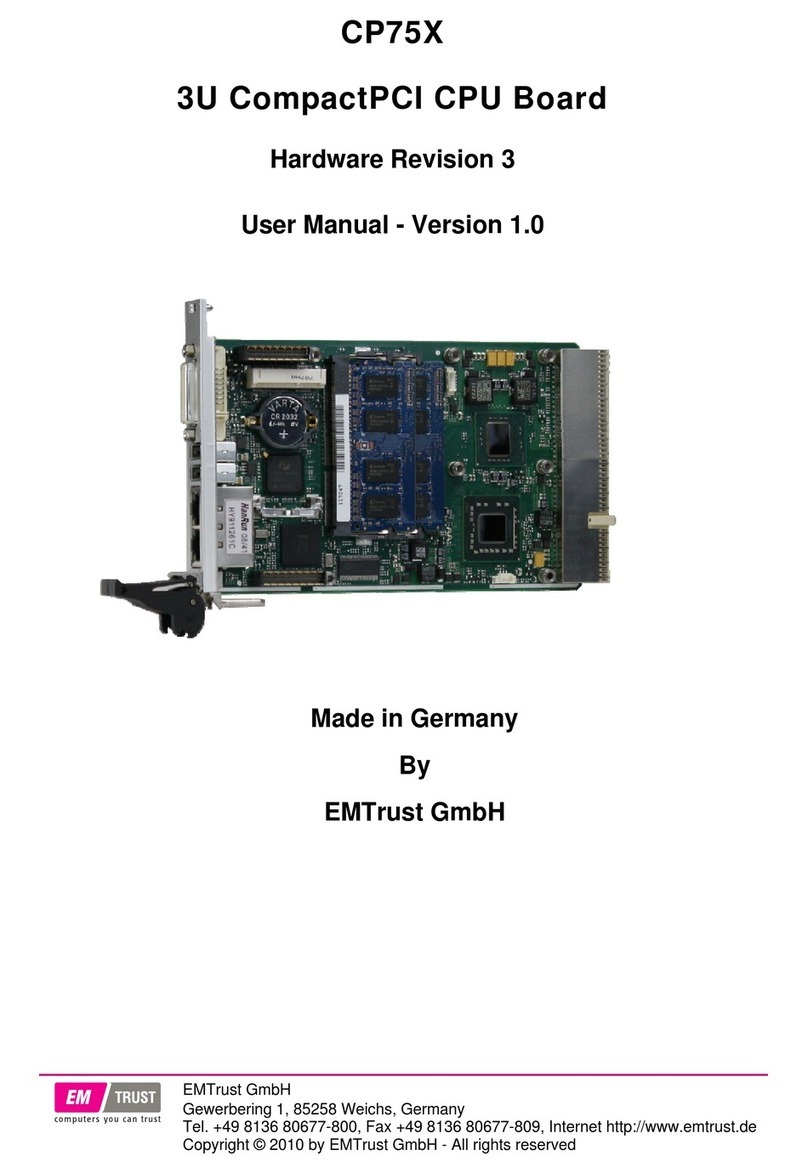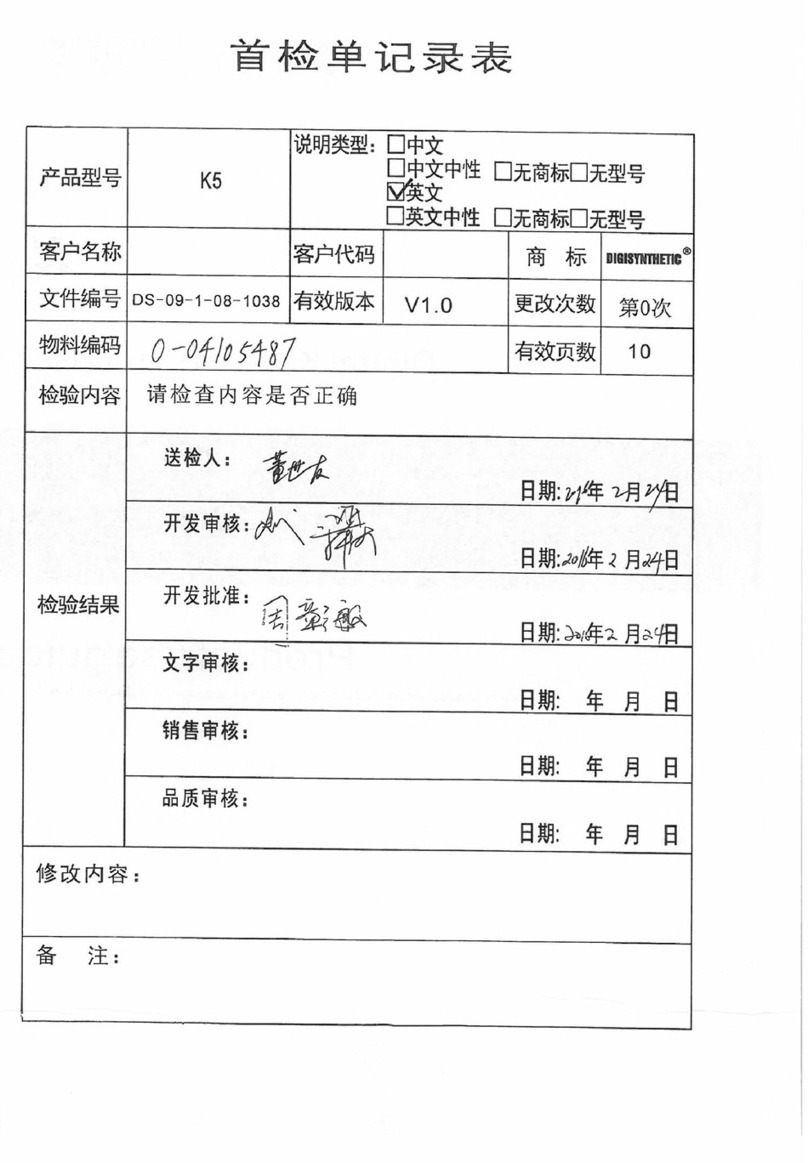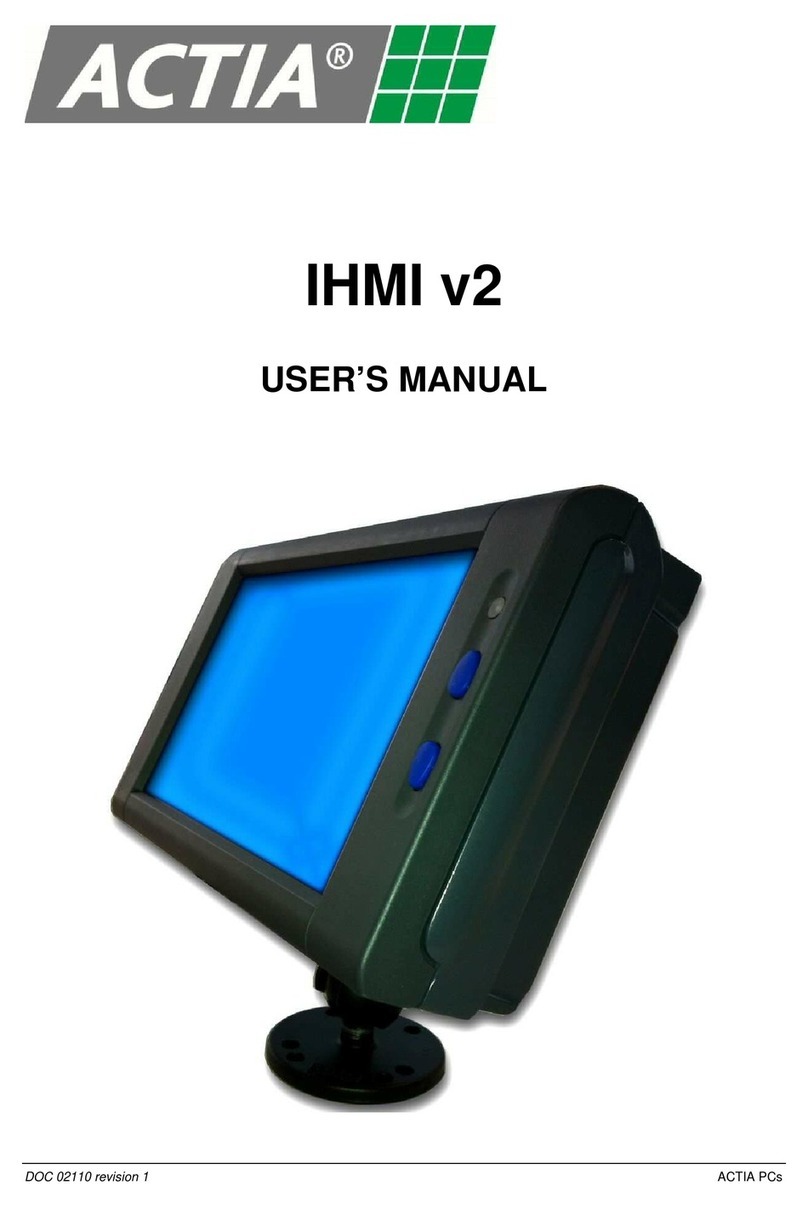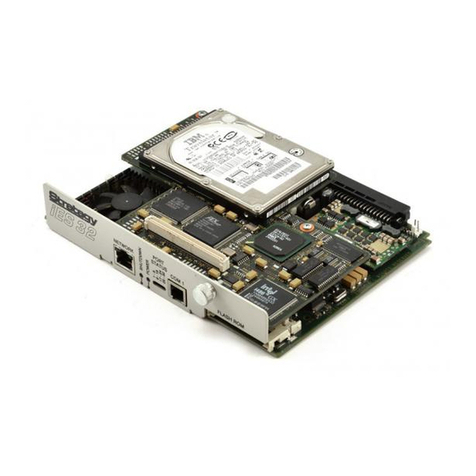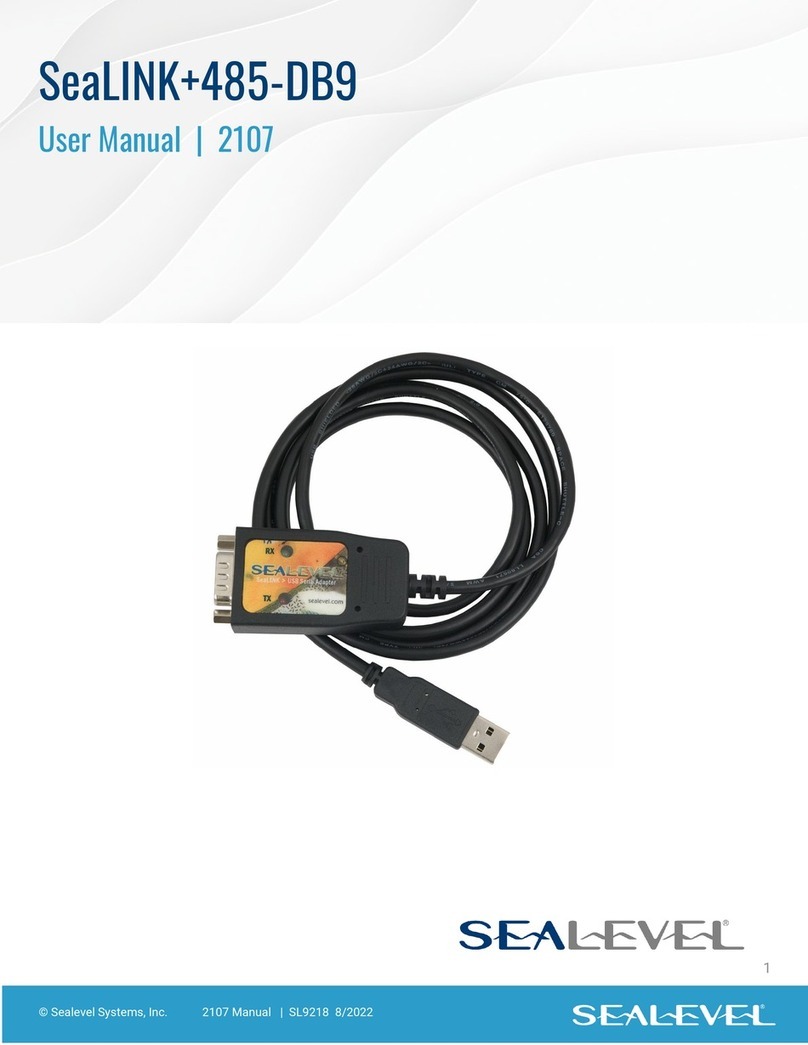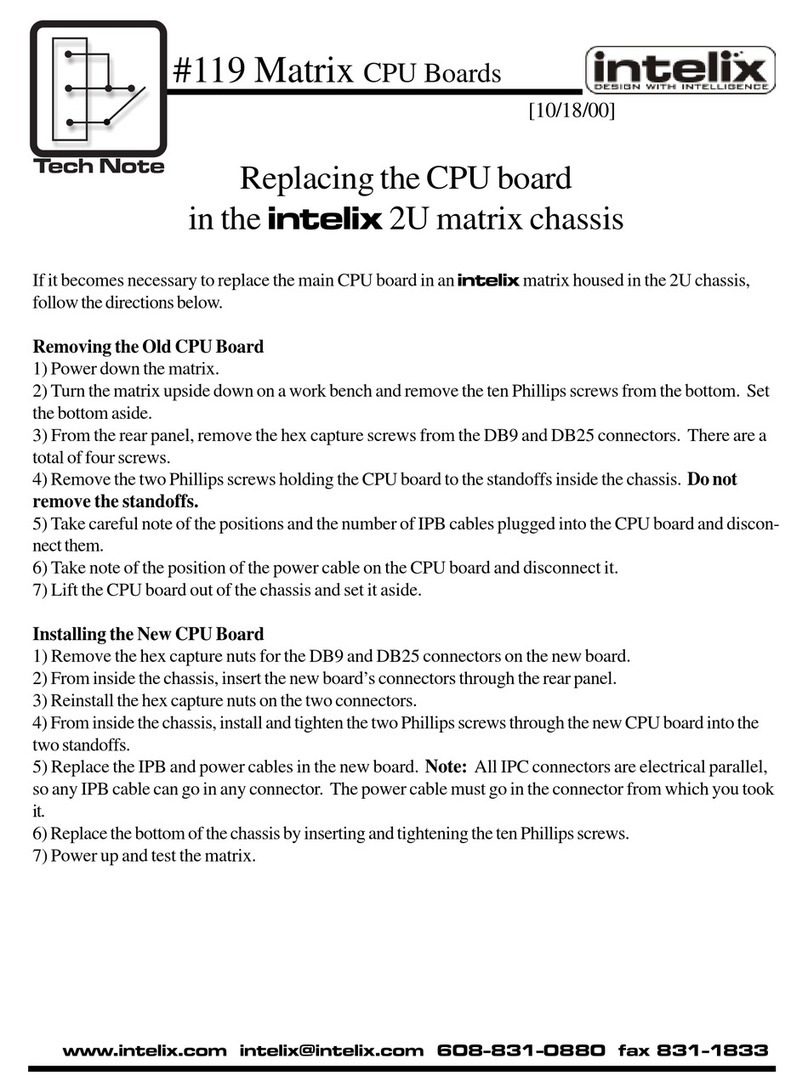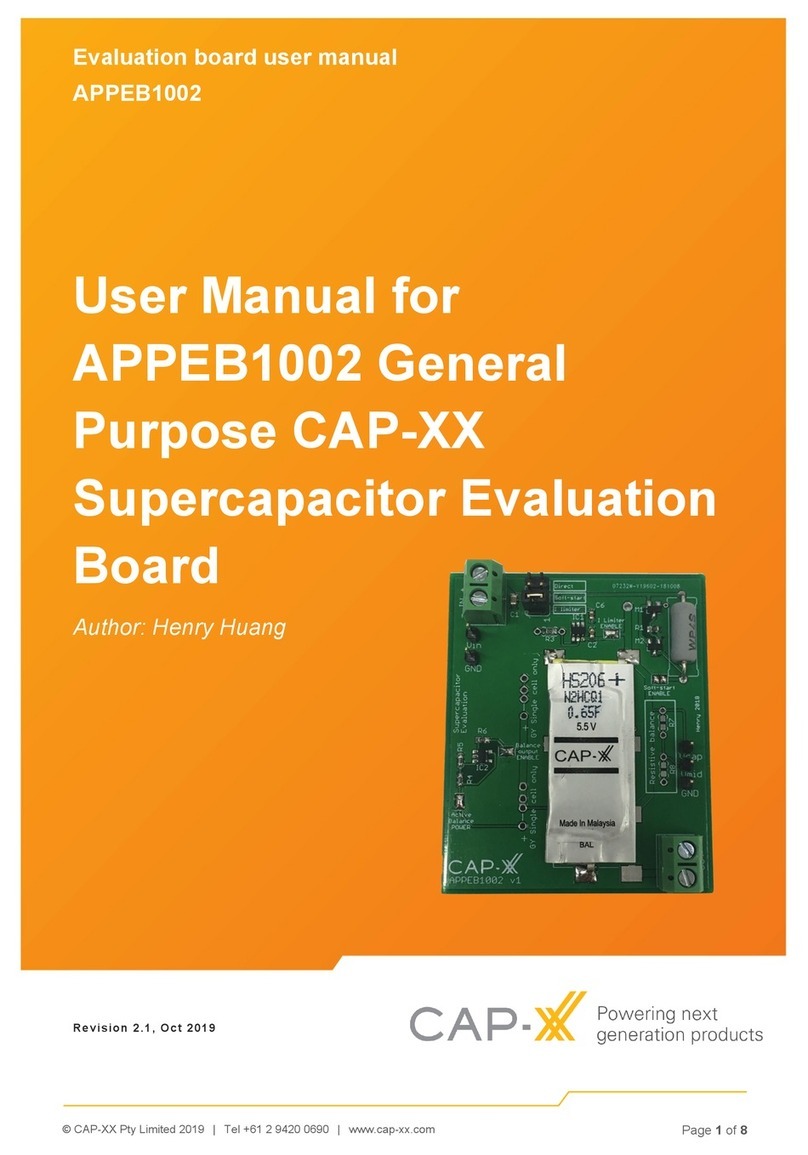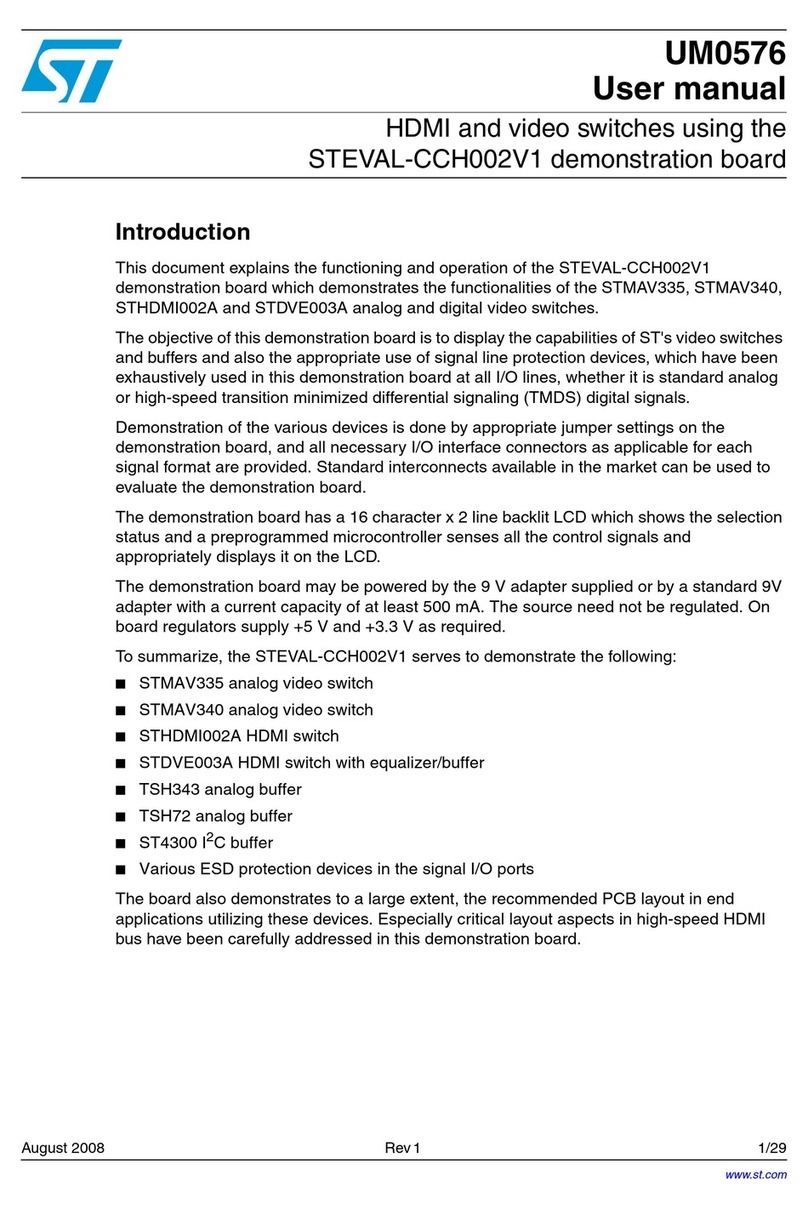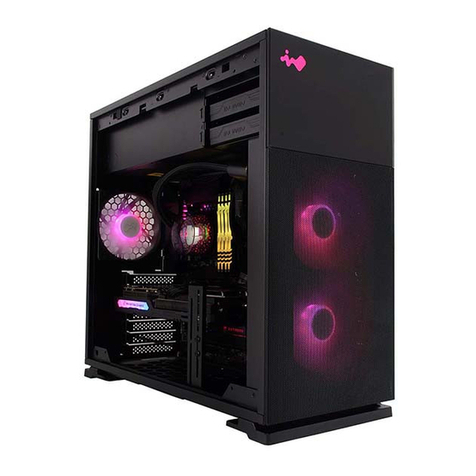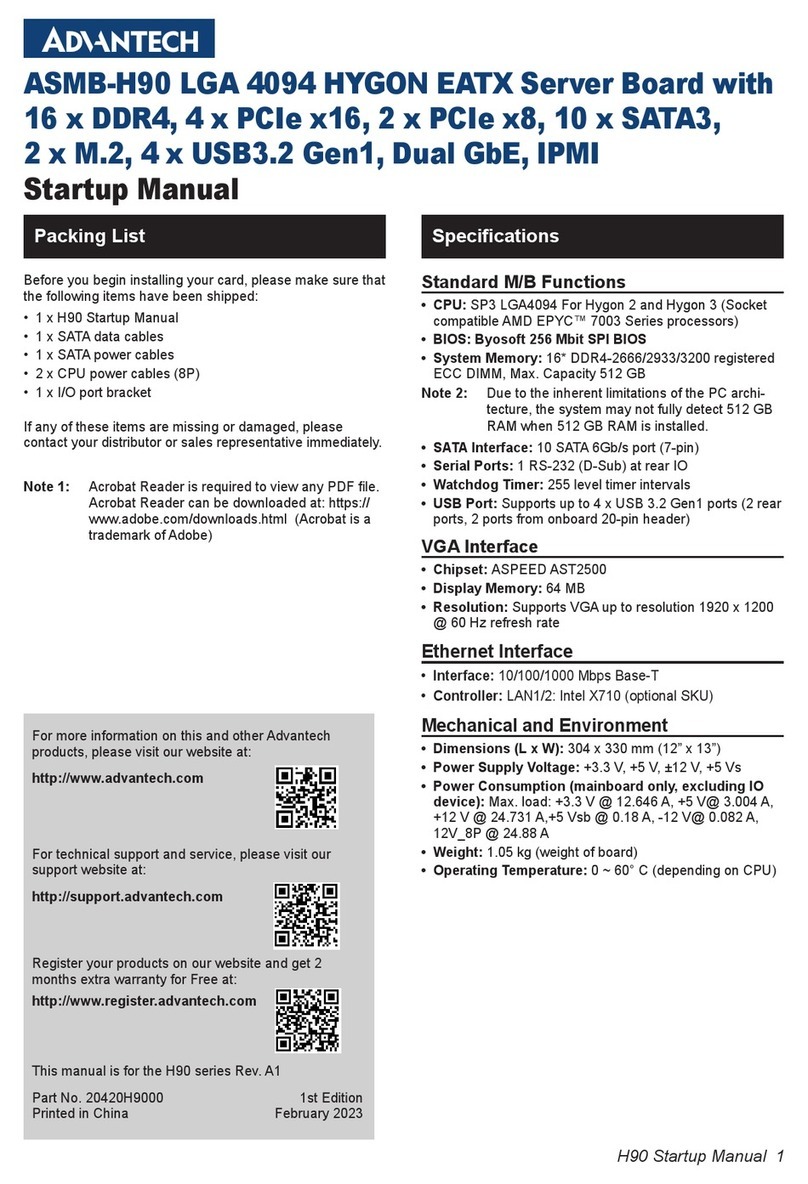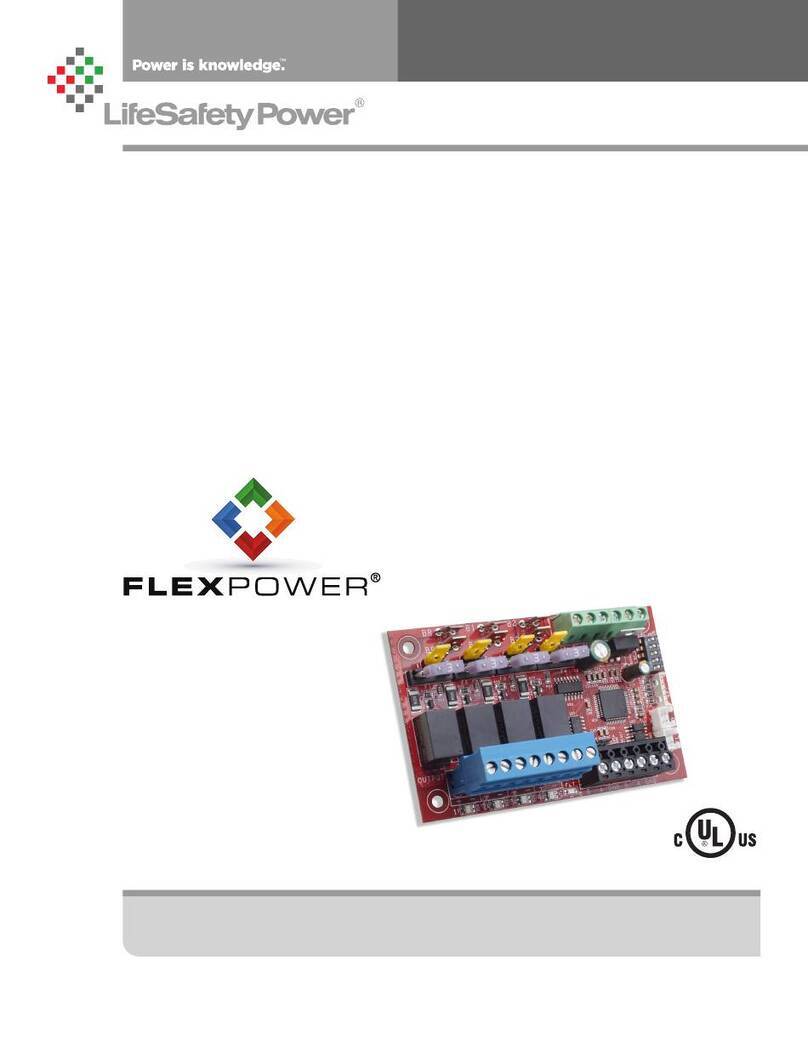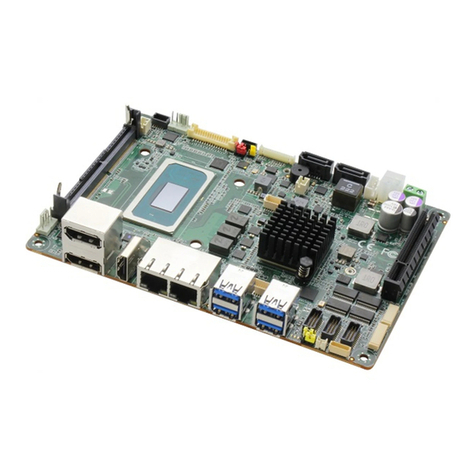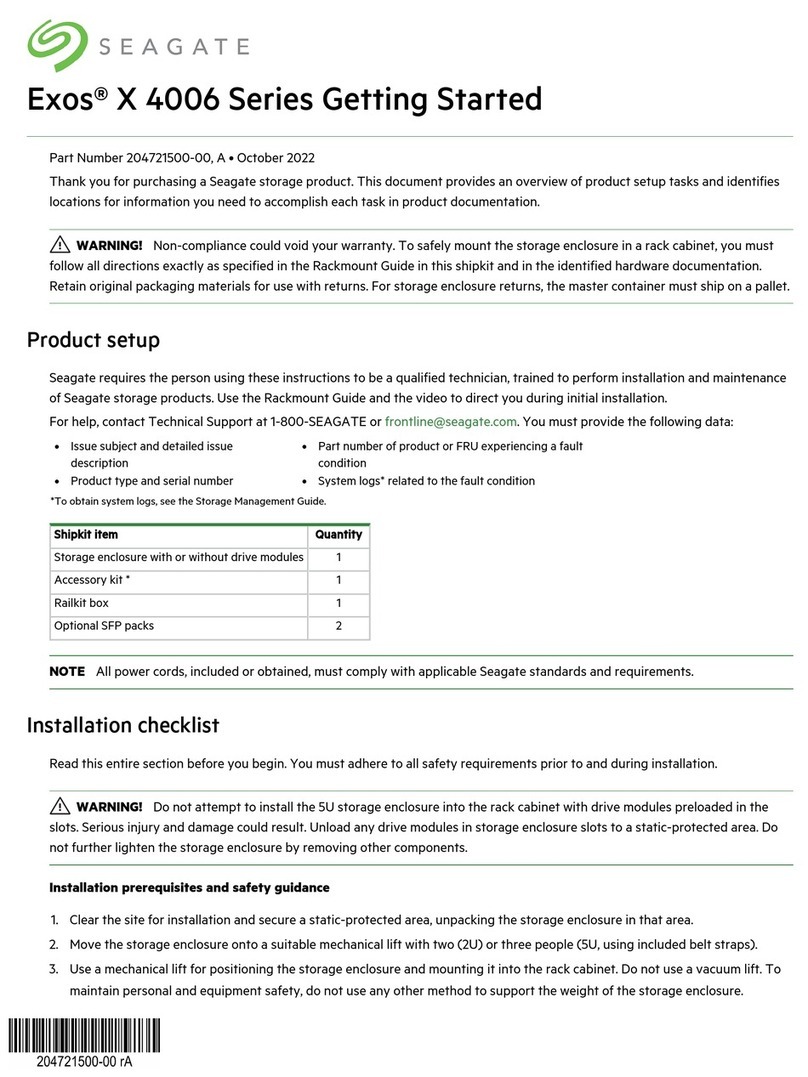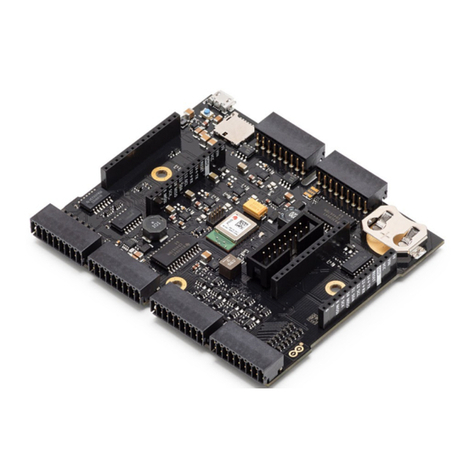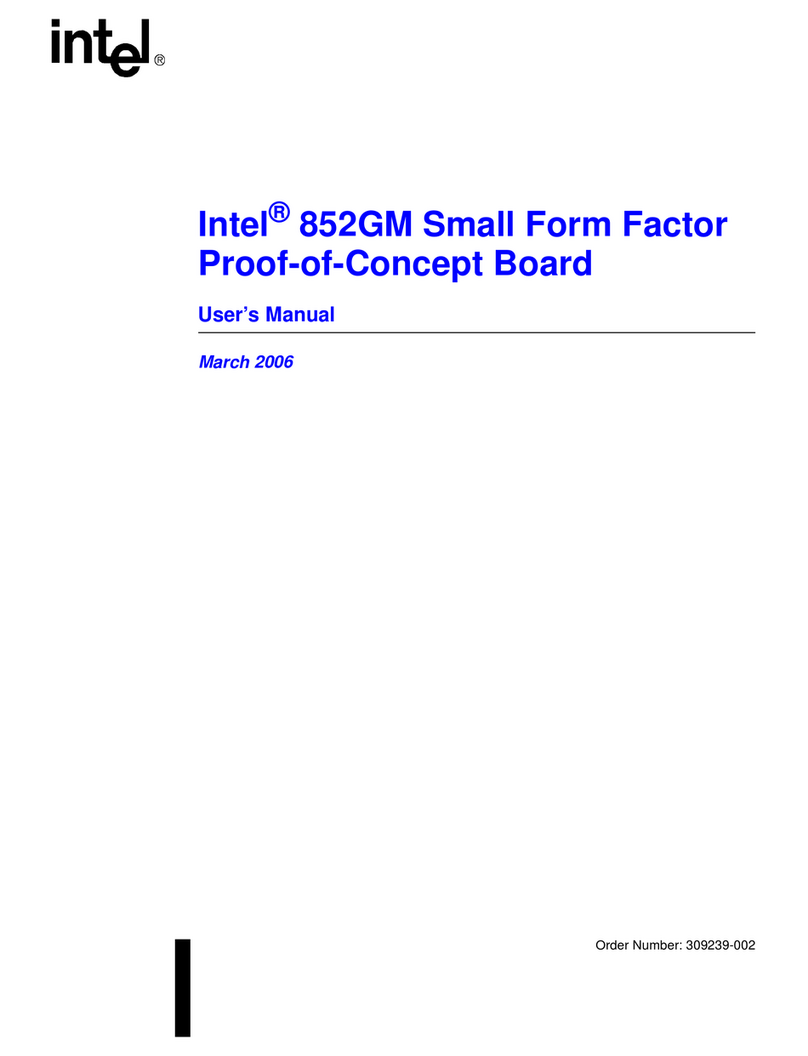Rockchip RK32 Series Guide

RK3288 Hardware Design Guide
RK3288
Hardware
Design Guide
Revision 1.2
Jun.18, 2014

RK3288 Hardware Design Guide
Revision History
Date
Revision
Description
2014-12-15
1.2

RK3288 Hardware Design Guide
Table of Contents
Table of Contents.....................................................................................................3
Warranty Disclaimer.................................................................................................5
1 RK3288 Brief Introduction ......................................................................................6
1.1 Chip Overview ........................................................................................... 6
1.2 Chip Feature .............................................................................................. 7
2 Selection of Reference Schematic .......................................................................... 10
3 PCB Design ........................................................................................................ 14
3.1 Structure..................................................................................................14
3.2 Design Rule ..............................................................................................15
3.3 Test Point .................................................................................................18
3.4 Silk-screen and Decal ................................................................................19
4 Thermal Dissipation............................................................................................. 20
5 POWER.............................................................................................................. 24
5.1 Schematic ................................................................................................24
5.2 PCB Layout...............................................................................................26
5.3 SYR827, SYR828 PCB Layout Guide .............................................................29
5.4 PMIC RC5T620 ..........................................................................................31
5.5 PMIC ACT8846 ..........................................................................................34
6 GPIO................................................................................................................. 40
6.1 Schematic ................................................................................................40
7 CPU&PMU .......................................................................................................... 42
7.1 Schematic ................................................................................................42
7.2 PCB Layout...............................................................................................43
8 DDR Controler & DRAM........................................................................................ 44
8.1 Schematic ................................................................................................44
8.2 PCB Layout(DDR0 channel,DDR1 channel).................................................49
9 Flash control & Memory ....................................................................................... 52
9.1 Schematic ................................................................................................52
9.2 PCB Layout...............................................................................................55
10 TF Card ........................................................................................................... 57
10.1 Schematic ..............................................................................................57
10.2 PCB Layout .............................................................................................58
11 USB & HSIC ..................................................................................................... 59
11.1 Schematic ..............................................................................................59
11.2 PCB Layout .............................................................................................60
12 SarADC & Key................................................................................................... 63
12.1 Schematic ..............................................................................................63
12.2 PCB Layout .............................................................................................64
13 DVP Interface & Camera..................................................................................... 65
13.1 Schematic ..............................................................................................65
13.2 PCB Layout .............................................................................................67
14 Display Interface............................................................................................... 68
14.1 Schematic ..............................................................................................68
14.2 PCB Layout .............................................................................................73
15 LCM ................................................................................................................ 75
15.1 Schematic ..............................................................................................75
15.2 PCB Layout .............................................................................................78
16 Debug ............................................................................................................. 80
16.1 Schematic ..............................................................................................80
16.2 PCB Layout .............................................................................................80
17 Audio Codec & SPDIF......................................................................................... 81
17.1 Schematic ..............................................................................................81
17.2 PCB Layout .............................................................................................83
18 Touch Panel...................................................................................................... 84
18.1 Schematic ..............................................................................................84
18.2 PCB Layout .............................................................................................85
19 Sensor............................................................................................................. 86
19.1 Schematic ..............................................................................................86

RK3288 Hardware Design Guide
19.2 PCB Layout .............................................................................................88
20 eFUSE ............................................................................................................. 90
20.1 Schematic ..............................................................................................90
21 MAC ................................................................................................................ 91
21.1 Schematic ..............................................................................................91
21.2 PCB Layout .............................................................................................94
22 2G/3G/4G ........................................................................................................ 99
22.1 Schematic ..............................................................................................99
22.2 PCB Layout ...........................................................................................100
23 WIFI & BT ...................................................................................................... 103
23.1 Schematic ............................................................................................103
23.2 PCB Layout ...........................................................................................105
24 GPS .............................................................................................................. 112
24.1 PCB Layout ...........................................................................................112
25 NFC............................................................................................................... 114
25.1 Schematic ............................................................................................114
25.2 PCB Layout ...........................................................................................114

RK3288 Hardware Design Guide
Warranty Disclaimer
Rockchip Electronics Co., Ltd makes no warranty, representation or guarantee (expressed, implied, statutory, or otherwise) by
or with respect to anything in this document, and shall not be liable for any implied warranties of non-infringement,
merchantability or fitness for a particular purpose or for any indirect, special or consequential damages.
Information furnished is believed to be accurate and reliable. However, Rockchip Electronics Co., Ltd assumes no responsibility
for the consequences of use of such information or for any infringement of patents or other rights of third parties that may result
from its use.
Rockchip Electronics Co., Ltd’s products are not designed, intended, or authorized for using as components in systems intended
for surgical implant into the body, or other applications intended to support or sustain life, or for any other application in which
the failure of the Rockchip Electronics Co., Ltd’s product could create a situation where personal injury or death may occur,
should buyer purchase or use Rockchip Electronics Co., Ltd’s products for any such unintended or unauthorized application,
buyers shall indemnify and hold Rockchip Electronics Co., Ltd and its officers, employees, subsidiaries, affiliates, and distributors
harmless against all claims, costs, damages, expenses, and reasonable attorney fees arising out of, either directly or indirectly,
any claim of personal injury or death that may be associated with such unintended or unauthorized use, even if such claim
alleges that Rockchip Electronics Co., Ltd was negligent regarding the design or manufacture of the part.
Copyright and Patent Right
Information in this document is provided solely to enable system and software implementers to use Rockchip Electronics Co.,
Ltd ’s products. There are no expressed or implied copyright licenses granted hereunder to design or fabricate any integrated
circuits or integrated circuits based on the information in this document.
Rockchip Electronics Co., Ltd does not convey any license under its patent rights nor the rights
of others.
All copyright and patent rights referenced in this document belong to their respective owners
and shall be subject to corresponding copyright and patent licensing requirements.
Trademarks
Rockchip and RockchipTM logo and the name of Rockchip Electronics Co., Ltd’s products are trademarks of Rockchip Electronics
Co., Ltd. and are exclusively owned by Rockchip Electronics Co., Ltd. References to other companies and their products use
trademarks owned by the respective companies and are for reference purpose only.
Confidentiality
The information contained herein (including any attachments) is confidential. The recipient hereby acknowledges the
confidentiality of this document, and except for the specific purpose, this document shall not be disclosed to any third party.
Reverse engineering or disassembly is prohibited.
ROCKCHIP ELECTRONICS CO.,LTD. RESERVES THE RIGHT TO MAKE CHANGES IN ITS PRODUCTS OR PRODUCT
SPECIFICATIONS WITH THE INTENT TO IMPROVE FUNCTION OR DESIGN AT ANY TIME AND WITHOUT NOTICE
AND IS NOT REQUIRED TO UNDATE THIS DOCUMENTATION TO REFLECT SUCH CHANGES.
Copyright © 2015 Rockchip Electronics Co., Ltd.
All rights reserved. No part of this publication may be reproduced, stored in a retrieval system, or transmitted in any form or by
any means, electric or mechanical, by photocopying, recording, or otherwise, without the prior written consent of Rockchip
Electronics Co., Ltd.

RK3288 Hardware Design Guide
1 RK3288 Brief Introduction
1.1 Chip Overview
RK32xx is a high-performance processor for high-end tablet, laptop and intelligent
monitor, and it is also one of the most powerful solution for 4Kx2K TV box.
RK3288 integrates quad-core Cortex-A17 with separately Neon and FPU coprocessors,
shared 1 MB L2 Cache. It has dual channel 64bits (DDR3/LPDDR2/LPDDR3) controller, which
provides demanding memory bandwidth for high-performance and high-resolution
applications. It also supports 8GB (max) address space for the address bit which is more than
32bits.
Embedded latest generation and most powerful GPU(Mali-T764)will provide smooth
operation for high-resolution(max 3840X2160) display, as well as mainstream games.RK3288
is completely compatible with OpenVG1.1, OpenGL ES1.1/2.0/3.0, OpenCL1.1, RenderScript
and DirectX11. It has a great progress on 3D compared with similar products.
RK3288 supports almost full-format, including H.264 and 4Kx2K.
RK3288 provides complete set of high-performance peripheral interface to support
flexible outputs such as dual channel LVDS, dual channel MIPI-DSI, eDP1.1, HDMI2.0, also
supports dual channel MIPI-CSI2 interface capable of ISP with 1.3 million pixels.
RK32xx
1MB L2 Cache
HDMI 2.0
4Kx2K 60fps
12bits DVP I/F
Image Interface
2D Graphics
Engine
1080p Video
encoder
(H.264)
Mali T764
GPU
4Kx2K Video
decoder
(H.264, H.265)
JPEG Encoder
Image Enhance
processor
JPEG Decoder
SDR/DDR/LBA
Nand Flash x2
LPDDR2/LPDDR3
(1200Mbps 64bit)
External Memory Interface
DDR3/DDR3L
(1200Mbps 64bit)
SD3.0/MMC4.5 x2
eMMC4.5 I/F
USB OTG 2.0
SDIO 3.0
UARTx5
I2C x6
SPI(M/S) x3
GPIOx128
USB HOST 2.0 X 2
GMAC
(RGMII/RMII)
I2S/PCM (8ch)
HSADC TS I/F
Connectivity
DMACx2 (13ch)
Int Controller
PMU
PWMx5(CABC)
WatchDog
Timerx8
Clock & Reset
System register
SAR-ADC
PLL x 5
System Peripheral
SRAM (96KB)
ROM (26KB)
eFuse
(32 x 32bits )
Memory
Multi-Media Processor
32KB I/D Cache
FPU/Neon
HSIC
GPS
32KB I/D Cache
Cortex-A12 Quad-Core
MIPI-CSI2 4 Lane
MIPI-CSI2 4 Lane
Or
MIPI_DSI 4 Lane
Dual Channel LVDS
Or
Parallel RGB interface
MIPI-DSI 4 Lane
1.0Gbps/lane
eDP1.3 4xlane
2.7Gbps/lane
SPDIF (8ch)
DVFS
DVFS
TS-ADC
13MP ISP
Security
(HDCP2.0,DRM,Sboot,Sdebug)
TS stream process
Crypto
Smart Card
PS/2
C2C
Fig 1-1

RK3288 Hardware Design Guide
1.2 Chip Feature
CPU
Quad-core Cortex-A17
Separately Integrated Neon and FPU per CPU
32KB/32KB L1 ICache/DCache per CPU
Unified 1MB L2 Cache
LPAE (Large Physical Address Extensions) , Support up to 8GB address space
Virtualization Extensions Support
DVFS support
GPU
3D GPU
Quad-Core Mali-T7 series, latest powerful graphics processor
Architected for GPU computing
Support OpenGL ES1.1/2.0/3.0, OpenVG1.1, OpenCL1.1 and Renderscript ,
Directx11
DVFS support
2D GPU
Multi-Core architecture
Up to 8Kx8K input and 4Kx4K output
High-quality image scale up/down
Dither operation
Image rotation with 90/180/270 degree or x/y-mirror
BitBLT, Alpha Blending,Raster Operation
VPU
Video Decoder
Support MPEG-2,MPEG-4,AVS,VC-1,VP8,MVC with up to 1080p@60fps
Support multi-format video decoder with up to 4Kx2K
High-quality deinterleave
Video Encoder
Support muti-format video encoder with up to 1080p@30fps
Video Interface
Video Input

RK3288 Hardware Design Guide
Dual-channel input for front and rear camera
Dual-channel MIPI-CSI2 interface with 4-lane per channel
8/10/12 bits standard DVP interface
Maximum 5Mpixel for front camera
Maximum 13Mpixel for rear camera with high-performance ISP
Video display
Dual-panel display with 2 separately interface
Maximum resolution is 4Kx2K
CABC support to decrease interface power
Dual channel 8/10bits LVDS
Dual channel MIPI-DSI
HDMI2.0 to support maximum 4Kx2K display
Optional eDP1.1 interface
Memory Interface
Nand Flash Interface
Dual-channel , 8bits per channel
Compatible with all of SLC/MLC/TLC Nand Flash, including DDR Nand
Embedded 60bits hardware ECC
8 chip selects to support more device
eMMC Interface
Compatible with eMMC4.5 standard
8bits data width
Support DDR-50,SDR-100
DDR interface
Dual channel 64bits interface
Support DDR3/DDR3L/LPDDR2/LPDDR3
Rich Connectivity
3 SD/MMC/SDIO interface, compatible with SD3.0,SDIO3.0 and MMC4.5
One 8-channels I2S/PCM interface, One 8-channels SPDIF interface
One USB2.0 OTG , Two USB2.0 Host

RK3288 Hardware Design Guide
100M/1000M RMII/RGMII Ethernet interface
Dual channel TS stream interface, descramble and demux support
Smart Card interface
GPS baseband interface
PS/2 master interface
5 UART, 3 SPI (master or slave), 6 I2C(up to 4Mbps), 5 PWM
Others
Standalone crypto and decrypto, compatible with AES 128bits/DES/3DES/SHA-1/
SHA-256/MD5/160bits PRNG
Full security solution to support HDCP2.x,secure boot, secure debug and DRM.
Temperature Sensor to support better temperature controll inside chip

RK3288 Hardware Design Guide
2 Selection of Reference Schematic
RK3288 integrates multiple function modules, basically each module has its own power
supply, and power pins of each module should be packaged within its own domain. In order to
avoid too many schematic versions as well as repeated corrections, function modules is
designed in separated pages and groups, and add some options in common use, as shown in
Fig 2-1. Customer can adjust schematic based on actual demands, please refer to RK3288
reference design published by RK for more details.
Fig 2-1

RK3288 Hardware Design Guide
For example, customer has below requirement:
RK3288 Sample Plan One
DC 5V Fire bull Charger
No
USB Charger
Yes
Battery
1-Cell
DRAM
1GB,4 x 16bit DDR3
FLASH
8GB,Emmc
LCM
10.05'' eDP,2560 x 1600
Front Camera
OV2659
Rear Camera
MIPI FX288A R2.0(OV8825)
HDMI
Yes(Type C)
USB OTG 2.0
Micro-B
TF Card
Yes
Audio Codec
Yes
Microphone
Yes
Audio Jack
Yes
Vibration
Yes
G-Sensor
Yes
Gyroscope
Yes
WIFI Module
802.11 a/b/g/n, BT 4.0
GPS
No
3G
No
4G
No
Based on this requirement, complete schematic can be finalized by omitting unnecessary
parts as shown in below Fig 2-2.

RK3288 Hardware Design Guide
Fig 2-2
Tips: If 9.7’’ eDP screen is adapted, please chose 2-cell battery to ensure stability of
system and display. For other screens, suggest to use 1-cell battery for lower cost.
Another example, customer raises below request:
RK3288 Sample Plan Two
DC 5V Fire Bull Charger
No
USB Charger
Yes
Battery
1-Cell
DRAM
2 x 32bit LPDDR2(POP Package)
FLASH
8GB,EMMC and NAND FLASH double Layout
LCM
2:8.9'' Dual MIPI,2560 x 1600
Front Camera
No
Rear Camera
MIPI FX288A R2.0(OV8825)
HDMI
No
USB OTG 2.0
Micro-B
Touch
COB,CT363

RK3288 Hardware Design Guide
TF Card
Yes
Audio Codec
Yes
Microphone
Yes
Audio Jack
Yes
Vibration
Yes
G-Sensor
Yes
Gyroscope
Yes
WIFI Module
802.11 a/b/g/n, BT 4.0
GPS
Yes
3G
Yes
4G
No
Efuse
Yes
Based on this requirement, complete schematic can be finalized by omitting unnecessary
parts as shown in below Fig 2-3.
Fig 2-3

RK3288 Hardware Design Guide
3 PCB Design
3.1 Structure
PCB design is quite crucial to ensure stability and performance of product, more attention
should be paid to this part. To ensure higher performance of RK3288, it is recommended to
use 6 layers or above PCB stack structure design with double-faced SMT. Suggest to take 1oz
copper foil to maximize PCB thermal dissipation.
6 layers PCB stack structure design shown as below (take a board with thickness of
1.2mm for example):
Name
Properties
Type/Spec
Thickness(mil)
Permittivity
Remark
Top
Signal1
Cu
0.7
-
Plating to 1oz
pp
FR-4
3.8
4.3
-
L2
Gnd1
Cu
1.5
-
1oz
core
FR-4
8
4.3
-
L3
Signal2
Cu
1.5
-
1oz
PP
FR 4
-
4.3
Adjust according
to thickness
L4
Power
Cu
1.5
-
1oz
core
FR-4
8
4.3
-
L5
Gnd2
Cu
1.5
-
1oz
pp
FR-4
3.8
4.3
-
Bottom
Signal3
Cu
0.7
-
Plating to 1oz
If with GPS, suggest to switch Bottom layer with L5, take GND2 layer as Bottom, DDR
corresponding area on L3 is DDR power, route DDR on L5, empty L4 above DDR area, and the
impedance control of traces on L5 only refer to Bottom layer.
8 layers PCB stack structure design shown as below (GPS is considered to be used):
Name
Properties
Type/Spec
Thickness(mil)
Permittivity
Remark
Top
Signal1
Cu
0.7
-
Plating to 1oz
pp
FR-4
3.8
4.3
-
L2
Gnd1
Cu
1.5
-
1oz

RK3288 Hardware Design Guide
pp
FR-4
3.8
4.3
-
L3
Signal2
Cu
1.5
-
1oz
core
FR-4
8
4.3
-
L4
Gnd2
Cu
1.5
-
1oz
pp
FR-4
-
4.3
Adjust according to
thickness
L5
Power
Cu
1.5
-
1oz
core
FR-4
8
4.3
-
L6
Signal3
Cu
1.5
-
1oz
pp
FR-4
3.8
4.3
-
L7
Signal4
Cu
1.5
-
1oz
pp
FR-4
3.8
4.3
-
Bottom
Gnd3
Cu
0.7
-
Plating to 1oz
3.2 Design Rule
In the product planning state, recommend to choose the design in which capacitors
can be placed on the reverse side of CPU.
The size of vias under CPU is 0.2mm/0.35mm (inside/outside diameter).
In order to suppress EMI, the PCB trace must follow the 3W principle,and the
clearance of traces must be kept 3 times of trace width., as shown in Fig 3-1, the trace
width/clearance of traces should be 4/8mil.
Fig 3-1
Please follow 20H principle on power layer to suppress power radiation.
2mm distance should be reserved between shield wall and PCB edge.

RK3288 Hardware Design Guide
Main components(CUP,DDR) and signal traces are mainly placed on TOP or BOTTOM
layer;
Small components like filter capacitor are mainly placed on TOP or BOTTOM layer; big
components can be placed on these two layers as well if structure is allowed.
Shielding:
Shielding case is necessary on TOP layer of PCB to suppress EMI and improve the
reliability of product, it also works as a heat sink of CPU to improve heat
dissipation effect.
If space is allowed, reserve a shielding case space on BOTTOM layer as well, or
reserve a big GND area with solder mask for shielding of coordination structure.
Copper integrity:Integrity and continuity of copper under CPU can guarantee the
signal return path, improve signal transmission quality and stability of product as well
as strengthen heat dissipation performance of copper, as shown in below Fig. Please
follow below recommendations to ensure integrity and continuity of copper and
improve performance of product,
Fig 3-2
Set copper layer as split/mixed;
The clearance between the via and the copper is 5.5mils;

RK3288 Hardware Design Guide
Fig 3-3
The width of copper trace is recommended to be 4mils;
The signal fan from CPU pins should be in alignment and reasonable as shown in
below Fig:
Fig 3-4
Tips:
3W Principle:Guarantee enough clearance to reduce trace to trace crosstalk. If the
clearance is not less than 3 times of trace width, it can reduce crosstalk between the
traces up to 70%.
20H Principle:Shrink power supply layer which can makes the electric field conduct
within the GND layer only. Take an H(the thickness of dielectric layer between power
and ground layer)as a unit, inside shrink 20H can suppress 70% of electrical filed
within the GND edge, while 98% for 100H.

RK3288 Hardware Design Guide
3.3 Test Point
Add test points on EMMC_CLKO, FLASH_CLE signal for eMMC, Nand Flash, it will be
more convenient to enter maskrom burning mode for debugging.
Fig 3-5
Suggest to add signal test points to interfaces like camera, TP, LCM which is
convenient for factory SMT test;
Fig 3-6

RK3288 Hardware Design Guide
3.4 Silk-screen and Decal
Add PCB name and layout data for searching and debugging;
Add components labels as many as possible for debugging;
Add silk-screen for key signals such as battery solder pins, connector pins, etc.
Add obvious remark for CPU 1st pin, without overlapped or hidden under device;
Make sure component package size is properly within height limit;
Make sure welding direction (especially for sink-style) of interface components like
headset/USB will not have mirror mistakes.
Recommend not to place big components on the reverse side of BGA for double-faced
SMT; All components should be located in slotted area for slotted single-faced SMT.

RK3288 Hardware Design Guide
4 Thermal Dissipation
CPU is the maximum heat component on RK3288 production which is the main object for
thermal dissipation processing.
Other main heating components are PMIC, charger IC and its inductors, backlight IC and
power inductors. In addition, power traces with large currents (trace from DC socket to
charger IC, battery to VCC_SYS of PMU) will have thermal effect for whole machine. These
thermal sources should be placed respectively; keep trace as short, wide as possible for large
current sources.
Due to radiation diffusion characteristics of thermal, heat source should be the center of
CPU heat sink, make heat sink as a square or roundness instead of long strip. Heat sink
cooling effect will not be proportional to its size, 6cm*6cm graphite heat sink is the most
economic choice as Fig 4-3 from thermograph in below Fig 4-1.
Fig 4-1
Below three methods should be considered to improve heat conduction of PCB:
Place more enough vias under the thermal components;
Place continuous copper on the surface layers;
Add copper content (use 1oz for each layer)
This manual suits for next models
1
Table of contents
Other Rockchip Computer Hardware manuals

